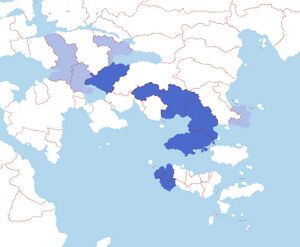Pan-Dolchism: Difference between revisions
No edit summary |
No edit summary |
||
| Line 1: | Line 1: | ||
'''Pan-Dolchism''' ({{wp|German Language|Dolch}}:Pandolchismus or Alldolch Bewegung), also known as '''Pan-Dolchicism''', is a {{wp|pan-nationalism|pan-nationalist}} {{wp|political ideology|political idea}}. Pan-Dolchists seek to unify all culturally, lingustically or ethnically Dolch peoples into a singular state. | '''Pan-Dolchism''' ({{wp|German Language|Dolch}}:Pandolchismus or Alldolch Bewegung), also known as '''Pan-Dolchicism''', is a {{wp|pan-nationalism|pan-nationalist}} {{wp|political ideology|political idea}}. Pan-Dolchists seek to unify all culturally, lingustically or ethnically Dolch peoples into a singular state. | ||
[[File:Pandolchism map.jpeg|thumb|Countries with a large Dolchic population (Blue), Countries with a significant Dolch minority (Light blue).]] | [[File:Pandolchism map.jpeg|thumb|Countries with a large Dolchic population (Blue), Countries with a significant Dolch minority (Light blue).]] | ||
Pan-Dolchic ideas began to originate in the 19th century, specifically in [[Dolchland]], which is seen as the main Dolchic homeland. Thinkers such as Georg Deutschemann and Karl Eigels. Some branches of Pan-Dolchicism have transformed into Pan-Buranicism, which includes associated groups such as Anglish, Ceriser, Variotic and Nordic. | Pan-Dolchic ideas began to originate in the 19th century, specifically in [[Dolchland]], which is seen as the main Dolchic homeland. Thinkers such as Georg Deutschemann and Karl Eigels, with more recent ideas being brought forth by [[Läkhart Viktor Drejlär]]. Some branches of Pan-Dolchicism have transformed into Pan-Buranicism, which includes associated groups such as Anglish, Ceriser, Variotic and Nordic. | ||
The [[Stedoria|Stedorian]] based [[Gemotamism]] movement is largely pan-dolchist, along with the ruling [[National Party of the Stedorian Revolution]]. Pan-Dolchic movements are also present in [[Dolchland]], [[Velaheria]], [[Walneria]], Western Ceris, [[Uppsund]], [[Transbaltia]] and [[Ahrana]], Pan-Dolchic groups also operate in south-western areas of [[Delamaria]] where the majority of its Dolch residents live. | The [[Stedoria|Stedorian]] based [[Gemotamism]] movement is largely pan-dolchist, along with the ruling [[National Party of the Stedorian Revolution]]. Pan-Dolchic movements are also present in [[Dolchland]], [[Velaheria]], [[Walneria]], Western Ceris, [[Uppsund]], [[Transbaltia]] and [[Ahrana]], Pan-Dolchic groups also operate in south-western areas of [[Delamaria]] where the majority of its Dolch residents live. | ||
[[Category: Eurth]] | [[Category: Eurth]] | ||
Revision as of 20:20, 24 January 2022
Pan-Dolchism (Dolch:Pandolchismus or Alldolch Bewegung), also known as Pan-Dolchicism, is a pan-nationalist political idea. Pan-Dolchists seek to unify all culturally, lingustically or ethnically Dolch peoples into a singular state.
Pan-Dolchic ideas began to originate in the 19th century, specifically in Dolchland, which is seen as the main Dolchic homeland. Thinkers such as Georg Deutschemann and Karl Eigels, with more recent ideas being brought forth by Läkhart Viktor Drejlär. Some branches of Pan-Dolchicism have transformed into Pan-Buranicism, which includes associated groups such as Anglish, Ceriser, Variotic and Nordic.
The Stedorian based Gemotamism movement is largely pan-dolchist, along with the ruling National Party of the Stedorian Revolution. Pan-Dolchic movements are also present in Dolchland, Velaheria, Walneria, Western Ceris, Uppsund, Transbaltia and Ahrana, Pan-Dolchic groups also operate in south-western areas of Delamaria where the majority of its Dolch residents live.
